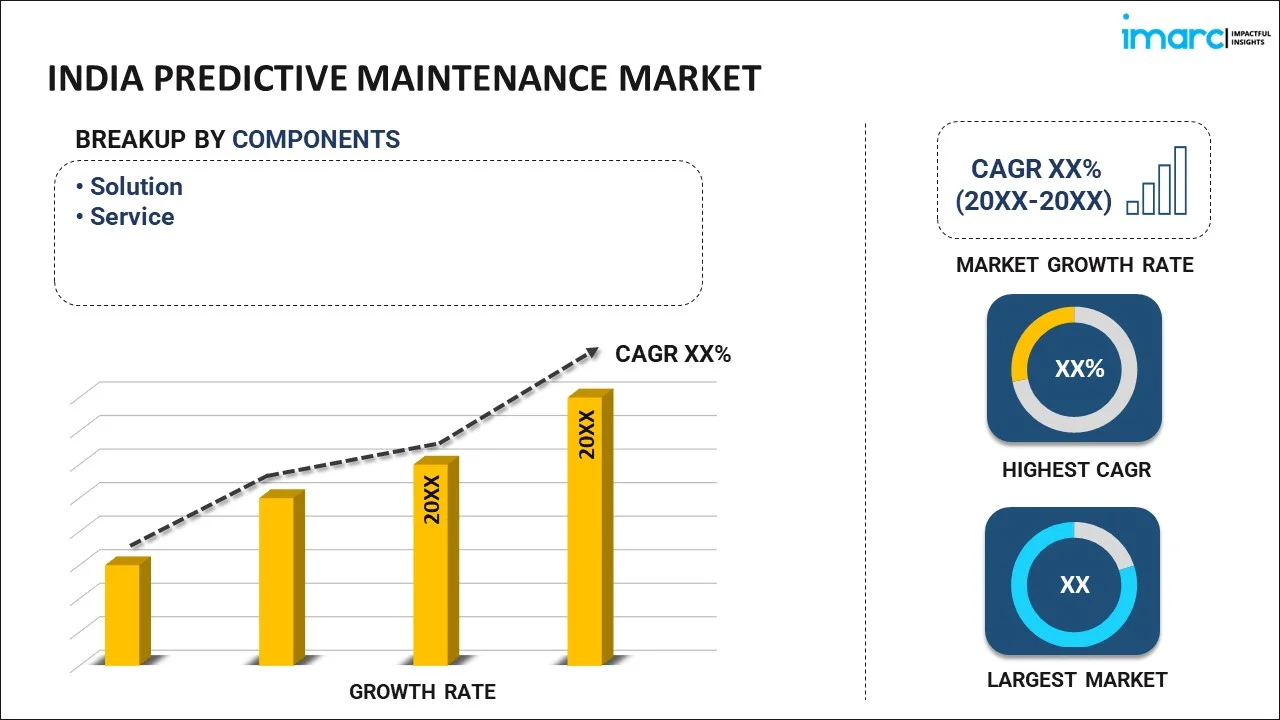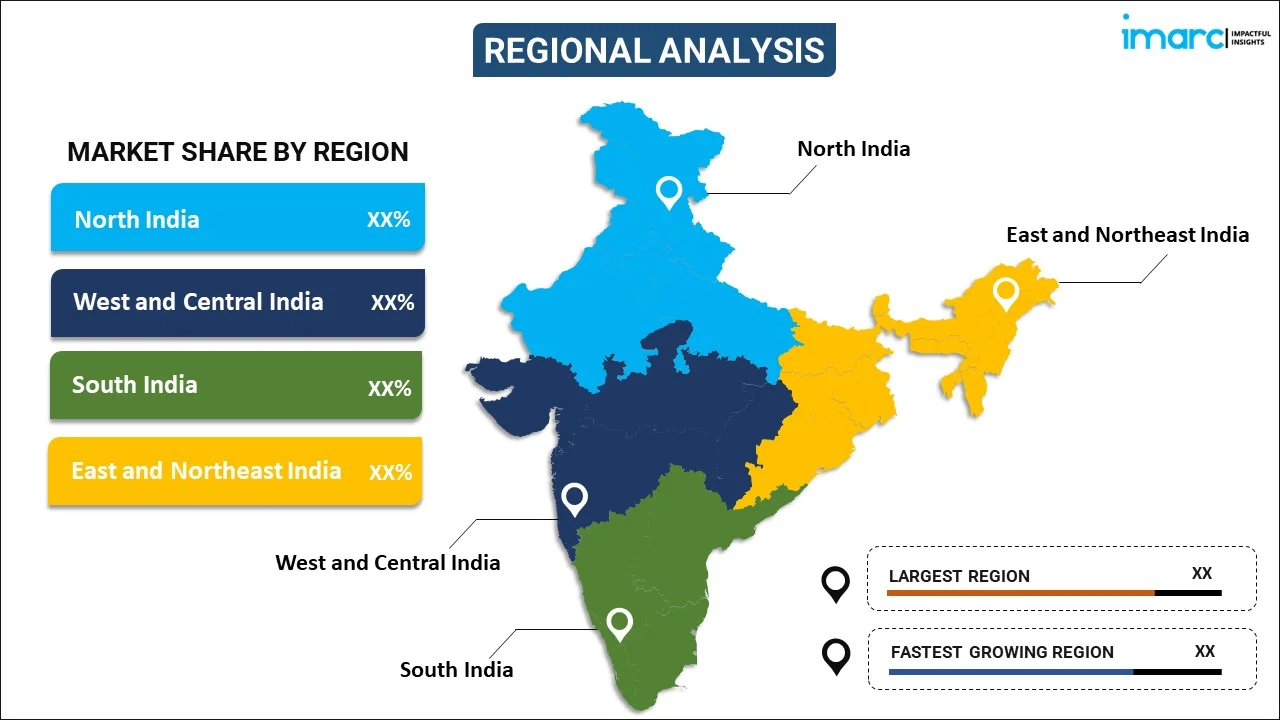
India Predictive Maintenance Market Report by Component (Solution, Service), Technique (Vibration Monitoring, Electrical Testing, Oil Analysis, Ultrasonic Leak Detectors, Shock Pulse, Infrared, and Others), Deployment Type (On-premises, Cloud-based), Organization Size (Large Enterprises, Small and Medium-sized Enterprises), Industry Vertical (Manufacturing, Energy and Utilities, Aerospace and Defense, Transportation and Logistics, Government, Healthcare, and Others), and Region 2025-2033
Market Overview:
India predictive maintenance market size reached USD 463.5 Million in 2024. Looking forward, IMARC Group expects the market to reach USD 2,837.2 Million by 2033, exhibiting a growth rate (CAGR) of 20.4% during 2025-2033. The increasing availability of big data analytics tools, which allows organizations to process and analyze large amounts of data generated by sensors and equipment, is driving the market.
|
Report Attribute
|
Key Statistics
|
|---|---|
|
Base Year
|
2024
|
|
Forecast Years
|
2025-2033
|
|
Historical Years
|
2019-2024
|
|
Market Size in 2024
|
USD 463.5 Million |
|
Market Forecast in 2033
|
USD 2,837.2 Million |
| Market Growth Rate 2025-2033 | 20.4% |
Predictive maintenance is a proactive approach to equipment upkeep that leverages advanced data analytics and technology to predict when machinery is likely to fail. By monitoring and analyzing real-time data from equipment sensors, historical performance records, and other relevant sources, predictive maintenance aims to identify potential issues before they lead to a breakdown. This strategy allows organizations to schedule maintenance activities strategically, minimizing downtime, reducing maintenance costs, and optimizing overall operational efficiency. Machine learning algorithms play a crucial role in predictive maintenance by learning patterns and trends from data, enabling the prediction of future equipment failures. This data-driven approach enhances equipment reliability, extends the lifespan of assets, and improves overall asset management, making it an integral part of modern maintenance practices in industries such as manufacturing, transportation, and energy.
India Predictive Maintenance Market Trends:
The predictive maintenance market in India is driven by several key factors that underscore its growing significance in various industries. Firstly, the escalating adoption of Industrial Internet of Things (IIoT) technologies serves as a foundational driver. As sensors and connected devices proliferate, they generate vast streams of real-time data, enabling predictive maintenance systems to analyze and anticipate equipment failures before they occur. Additionally, the increasing complexity of machinery and equipment in modern industrial settings necessitates a proactive approach to maintenance. This complexity, coupled with the demand for enhanced operational efficiency, propels the predictive maintenance market forward. Furthermore, the rising awareness of the potential cost savings associated with predictive maintenance is a pivotal driver. Organizations are recognizing that by predicting and preventing equipment failures, they can significantly reduce downtime, repair costs, and overall operational disruptions. Moreover, advancements in artificial intelligence and machine learning algorithms are pivotal connectors in this landscape. These technologies empower predictive maintenance solutions to continuously learn and evolve, refining their predictive capabilities over time. In essence, the convergence of IoT, machinery complexity, cost-consciousness, and cutting-edge technologies creates a compelling narrative for the robust growth of the regional predictive maintenance market in the foreseeable future.
India Predictive Maintenance Market Segmentation:
IMARC Group provides an analysis of the key trends in each segment of the market, along with forecasts at the country level for 2025-2033. Our report has categorized the market based on component, technique, deployment type, organization size, and industry vertical.
Component Insights:

- Solution
- Service
The report has provided a detailed breakup and analysis of the market based on the component. This includes solution and service.
Technique Insights:
- Vibration Monitoring
- Electrical Testing
- Oil Analysis
- Ultrasonic Leak Detectors
- Shock Pulse
- Infrared
- Others
A detailed breakup and analysis of the market based on the technique have also been provided in the report. This includes vibration monitoring, electrical testing, oil analysis, ultrasonic leak detectors, shock pulse, infrared, and others.
Deployment Type Insights:
- On-premises
- Cloud-based
The report has provided a detailed breakup and analysis of the market based on the deployment type. This includes on-premises and cloud-based.
Organization Size Insights:
- Large Enterprises
- Small and Medium-sized Enterprises
A detailed breakup and analysis of the market based on the organization size have also been provided in the report. This includes large enterprises and small and medium-sized enterprises.
Industry Vertical Insights:
- Manufacturing
- Energy and Utilities
- Aerospace and Defense
- Transportation and Logistics
- Government
- Healthcare
- Others
The report has provided a detailed breakup and analysis of the market based on the industry vertical. This includes manufacturing, energy and utilities, aerospace and defense, transportation and logistics, government, healthcare, and others.
Regional Insights:

- North India
- West and Central India
- South India
- East and Northeast India
The report has also provided a comprehensive analysis of all the major regional markets, which include North India, West and Central India, South India, and East and Northeast India.
Competitive Landscape:
The market research report has also provided a comprehensive analysis of the competitive landscape in the market. Competitive analysis such as market structure, key player positioning, top winning strategies, competitive dashboard, and company evaluation quadrant has been covered in the report. Also, detailed profiles of all major companies have been provided.
India Predictive Maintenance Market Report Coverage:
| Report Features | Details |
|---|---|
| Base Year of the Analysis | 2024 |
| Historical Period | 2019-2024 |
| Forecast Period | 2025-2033 |
| Units | Million USD |
| Scope of the Report | Exploration of Historical Trends and Market Outlook, Industry Catalysts and Challenges, Segment-Wise Historical and Future Market Assessment:
|
| Components Covered | Solution, Service |
| Techniques Covered | Vibration Monitoring, Electrical Testing, Oil Analysis, Ultrasonic Leak Detectors, Shock Pulse, Infrared, Others |
| Deployment Types Covered | On-premises, Cloud-based |
| Organization Sizes Covered | Large Enterprises, Small and Medium-sized Enterprises |
| Industry Verticals Covered | Manufacturing, Energy and Utilities, Aerospace and Defense, Transportation and Logistics, Government, Healthcare, Others |
| Regions Covered | North India, West and Central India, South India, East and Northeast India |
| Customization Scope | 10% Free Customization |
| Post-Sale Analyst Support | 10-12 Weeks |
| Delivery Format | PDF and Excel through Email (We can also provide the editable version of the report in PPT/Word format on special request) |
Key Questions Answered in This Report:
- How has the India predictive maintenance market performed so far and how will it perform in the coming years?
- What has been the impact of COVID-19 on the India predictive maintenance market?
- What is the breakup of the India predictive maintenance market on the basis of component?
- What is the breakup of the India predictive maintenance market on the basis of technique?
- What is the breakup of the India predictive maintenance market on the basis of deployment type?
- What is the breakup of the India predictive maintenance market on the basis of organization size?
- What is the breakup of the India predictive maintenance market on the basis of industry vertical?
- What are the various stages in the value chain of the India predictive maintenance market?
- What are the key driving factors and challenges in the India predictive maintenance?
- What is the structure of the India predictive maintenance market and who are the key players?
- What is the degree of competition in the India predictive maintenance market?
Key Benefits for Stakeholders:
- IMARC’s industry report offers a comprehensive quantitative analysis of various market segments, historical and current market trends, market forecasts, and dynamics of the India predictive maintenance market from 2019-2033.
- The research report provides the latest information on the market drivers, challenges, and opportunities in the India predictive maintenance market.
- Porter's five forces analysis assist stakeholders in assessing the impact of new entrants, competitive rivalry, supplier power, buyer power, and the threat of substitution. It helps stakeholders to analyze the level of competition within the India predictive maintenance industry and its attractiveness.
- Competitive landscape allows stakeholders to understand their competitive environment and provides an insight into the current positions of key players in the market.
Need more help?
- Speak to our experienced analysts for insights on the current market scenarios.
- Include additional segments and countries to customize the report as per your requirement.
- Gain an unparalleled competitive advantage in your domain by understanding how to utilize the report and positively impacting your operations and revenue.
- For further assistance, please connect with our analysts.
 Inquire Before Buying
Inquire Before Buying
 Speak to an Analyst
Speak to an Analyst
 Request Brochure
Request Brochure
 Request Customization
Request Customization




.webp)




.webp)












